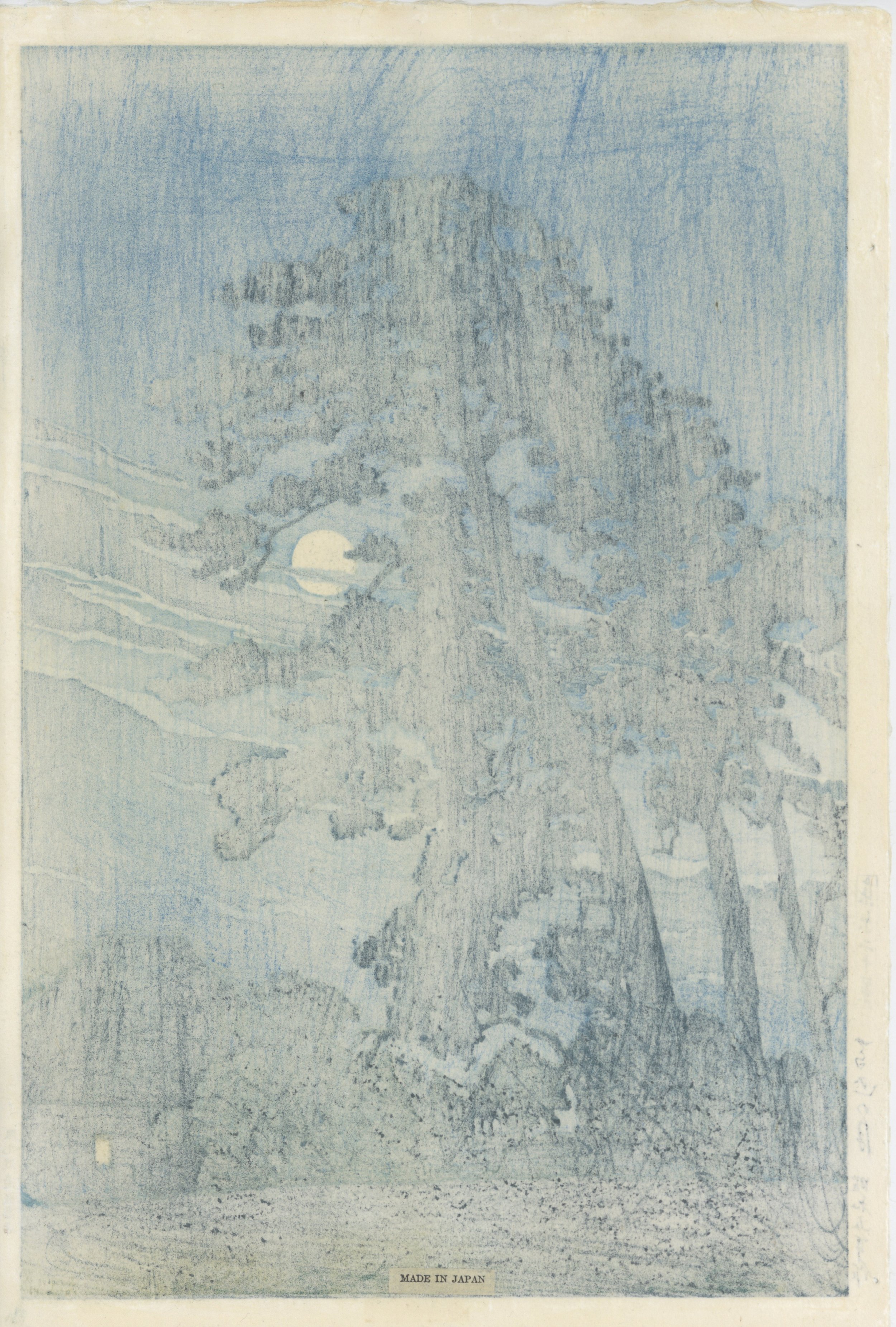Hasui | Moon at Magome, Twenty Views of Tokyo
川瀨巴水 Kawase Hasui ( 1883–1957)
东京二十景 馬込之月
Moon at Magome, from the series of Twenty Views of Tokyo
1930
木版画 | 纵绘大大判 | 39 x 26cm
Woodblock-print | Large Oban tate-e | 39 x 26cm
初摺;品相非常好
First edition; great condition
SOLD
马込町,旧地名,位于现东京都大田区北部一带。在整个江户时代,这里都是江户城外的一片农业区,名为马込村;随着明治维新以及大正期经济社会的发展,马込村的农田上也建起了越来越多的住宅;1928年,马込村改制为马込町;1930年,巴水搬入了町内的一套西式洋房,并在此度过了十余年的时光。
马込町曾有一处著名的地标——“马込三本松”。顾名思义,指的是三颗树龄约五六百年的巨大古松。可惜在昭和初期,三颗古松陆续消失,如今,就只剩下它们曾生长过的荒冢供人凭吊。
但巴水可是实实在在地领略过它们的壮美身姿,并且,还为后人留下了一幅不朽的杰作。在那个弥漫着“巴水蓝”的永恒夜晚,三本松就斜斜地耸立在熟悉的老地方。满月将树后的流云作为面纱,它柠檬色的脸庞却又穿过松枝,为世间带来光华。右下角的农家透出一小窗橘黄的灯火,似乎比月色更加温暖人的心房。门外这片耕垄的整整齐齐的田地,承载着未来播撒下的无限希望,一切的一切,此刻似乎都在缓慢而有力的生长。
画中的三本松与农家屋顶,以及交错的松枝与流云,都恰好形成了斜三角形。安定而平衡的构图,能让人下意识地提升对画面的好感度。这也正是本作能成为巴水最为人称赞的代表作的原因之一。三本松的魂灵,将永远地待在巴水的良夜里,不再逝去,不再被忘记。
Interested in purchasing?
Please contact us.
川瀨巴水 Kawase Hasui ( 1883–1957)
东京二十景 馬込之月
Moon at Magome, from the series of Twenty Views of Tokyo
1930
木版画 | 纵绘大大判 | 39 x 26cm
Woodblock-print | Large Oban tate-e | 39 x 26cm
初摺;品相非常好
First edition; great condition
SOLD
马込町,旧地名,位于现东京都大田区北部一带。在整个江户时代,这里都是江户城外的一片农业区,名为马込村;随着明治维新以及大正期经济社会的发展,马込村的农田上也建起了越来越多的住宅;1928年,马込村改制为马込町;1930年,巴水搬入了町内的一套西式洋房,并在此度过了十余年的时光。
马込町曾有一处著名的地标——“马込三本松”。顾名思义,指的是三颗树龄约五六百年的巨大古松。可惜在昭和初期,三颗古松陆续消失,如今,就只剩下它们曾生长过的荒冢供人凭吊。
但巴水可是实实在在地领略过它们的壮美身姿,并且,还为后人留下了一幅不朽的杰作。在那个弥漫着“巴水蓝”的永恒夜晚,三本松就斜斜地耸立在熟悉的老地方。满月将树后的流云作为面纱,它柠檬色的脸庞却又穿过松枝,为世间带来光华。右下角的农家透出一小窗橘黄的灯火,似乎比月色更加温暖人的心房。门外这片耕垄的整整齐齐的田地,承载着未来播撒下的无限希望,一切的一切,此刻似乎都在缓慢而有力的生长。
画中的三本松与农家屋顶,以及交错的松枝与流云,都恰好形成了斜三角形。安定而平衡的构图,能让人下意识地提升对画面的好感度。这也正是本作能成为巴水最为人称赞的代表作的原因之一。三本松的魂灵,将永远地待在巴水的良夜里,不再逝去,不再被忘记。
Interested in purchasing?
Please contact us.
川瀨巴水 Kawase Hasui ( 1883–1957)
东京二十景 馬込之月
Moon at Magome, from the series of Twenty Views of Tokyo
1930
木版画 | 纵绘大大判 | 39 x 26cm
Woodblock-print | Large Oban tate-e | 39 x 26cm
初摺;品相非常好
First edition; great condition
SOLD
马込町,旧地名,位于现东京都大田区北部一带。在整个江户时代,这里都是江户城外的一片农业区,名为马込村;随着明治维新以及大正期经济社会的发展,马込村的农田上也建起了越来越多的住宅;1928年,马込村改制为马込町;1930年,巴水搬入了町内的一套西式洋房,并在此度过了十余年的时光。
马込町曾有一处著名的地标——“马込三本松”。顾名思义,指的是三颗树龄约五六百年的巨大古松。可惜在昭和初期,三颗古松陆续消失,如今,就只剩下它们曾生长过的荒冢供人凭吊。
但巴水可是实实在在地领略过它们的壮美身姿,并且,还为后人留下了一幅不朽的杰作。在那个弥漫着“巴水蓝”的永恒夜晚,三本松就斜斜地耸立在熟悉的老地方。满月将树后的流云作为面纱,它柠檬色的脸庞却又穿过松枝,为世间带来光华。右下角的农家透出一小窗橘黄的灯火,似乎比月色更加温暖人的心房。门外这片耕垄的整整齐齐的田地,承载着未来播撒下的无限希望,一切的一切,此刻似乎都在缓慢而有力的生长。
画中的三本松与农家屋顶,以及交错的松枝与流云,都恰好形成了斜三角形。安定而平衡的构图,能让人下意识地提升对画面的好感度。这也正是本作能成为巴水最为人称赞的代表作的原因之一。三本松的魂灵,将永远地待在巴水的良夜里,不再逝去,不再被忘记。
Interested in purchasing?
Please contact us.
Kawase Hasui (1883–1957)
Hasui Kawase is perhaps the single most recognized woodblock artist of the Shin Hanga – new print – movement in the early- to mid-20th Century. Because he specialized in landscapes, many would say he was a successor to Hiroshige, noting his enveloping portrayals of nature, and his thoughtful placement of humans within them. But that would be too easy, because Hiroshige and Hasui in many ways could not be more different.
Whereas Hiroshige played with flat plains of negative space, Hasui embraced Western painting styles – if not techniques – to display water reflections, shadows and shades of light in all its combinations. You can easily discern the time of day and season from the light. Signs of the 20th Century Japan are everywhere – rickshaws, cars, telephone poles, steamships, even western-style umbrellas and rain slickers. Yes, he embraced snow and rain scenes like Hiroshige, and many famous views, but they live in a three-dimensional, modern world.
His prints are hugely sought-after today, with condition being extremely important to collectors. Many of the original woodblocks were destroyed in the Great Earthquake of 1923; finding examples of those pre-quake prints is challenging, indeed.
He was born Bunjiro Kawase in Tokyo in 1883, the son of a merchant. Hasui studied Japanese-style painting with Kiyokata and Western painting at the Hakubakai. He exhibited his first painting at 19. The publisher Shozaburo Watanabe – seeing the appeal of woodblock prints to the Western tourists then flooding Japan – took Hasui under his wing. The young man travelled widely to capture landscapes, making sketches as he went. Looking at the detail and perspective in some of his prints, one wonders: did he work from photographs as well?
Hasui’s Zojoji Temple in Snow – with a kimono-clad woman pushing against the furious snow with a traditional umbrella -- has been named an Intangible Cultural Treasure, the greatest artistic honor in postwar Japan. He died in 1957.
The publishers Doi, Kawaguchi, Sakai and others also produced some Hasui works. Learning to read the seals on the prints, and therefore dating them, takes time but is well worth it. If you can find this book at a reasonable price, go for it. It’s all there.


